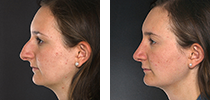Injuries to the face can be more than painful, they can be catastrophic in terms of the way they alter your appearance. When facial trauma occurs, it is essential you turn to a plastic surgeon that is experienced in these types of procedures to ensure the best possible outcome from your surgery. Dr. John Sherman has done more head trauma and fracture surgeries than most plastic surgeons in the [primary_city] area, giving him the experience and expertise to treat your injuries.
Types of Facial Trauma
Facial trauma may be the result of car accidents, domestic violence, animal bites, sports, fights, or a host of other circumstances and events. There are many types of facial trauma that may require plastic surgery to restore the patient’s appearance and self-confidence:
- Fractures or other injuries to the orbital bone
- Fractures to the cheekbone
- Fractures to the upper or lower jawbones
- Fractures of the forehead and frontal sinuses
- Fractures of the nasal bone
In addition to fractures, patients may seek the help of a plastic surgeon to restore the appearance after significant lacerations, poor wound or scar healing, or extensive cancer repair. These procedures do more than provide cosmetic benefits, they can help patients move forward after traumatic events on both a psychological and emotional level.
Repairing Facial Fractures
The first goal in repairing any facial fracture is to place bones back into their proper position, a process known as reduction. Once they are in the proper position, they must be held there until the bone actually heals, which is referred to as stabilization. Stabilization of facial fractures is not as easy as stabilization of other broken bones – after all, you cannot put a cast on your eye socket or cheekbone! Instead, stabilization of these bones typically involves the placement of plates or screws at the site of the fracture.
Stabilization techniques for facial fractures need to be completed with the overall aesthetic result in mind. This means any necessary incisions should be small and inconspicuous to avoid too much visible scarring after healing is complete. When reduction and stabilization are complete, additional procedures may be recommended to completely restore the patient’s appearance after the facial trauma.
Finding the Right Surgeon
When patients first encounter facial trauma, they may not think about the long-term consequences of their treatment. However, when bones are not reduced or stabilized properly at the beginning, revision surgery may be necessary to correct positioning and create an enhanced aesthetic result. Because plastic surgeons are experienced in seeing treatment in terms of form as well as function, they are often uniquely qualified to treat various types of facial trauma most effectively.
Facial trauma is more than a physical injury, it can impact your mental and emotional health as well as your self-esteem. Seeking proper treatment for your injury can make all the difference in the outcome of your procedure on many different levels. It is important to choose a plastic surgeon that will keep both form and function in mind as you work through the healing process from your injury.
Dr. Sherman is a plastic surgeon in [primary_city] that is uniquely qualified to treat all types of facial trauma. If you have suffered a serious injury, contact our office today to learn more about your treatment options at [primary_phone].




